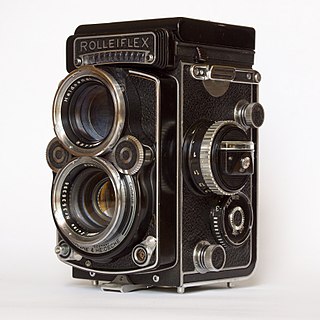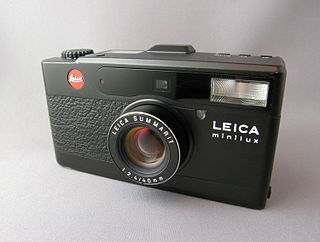
Minolta Co., Ltd. was a Japanese manufacturer of cameras, camera accessories, photocopiers, fax machines, and laser printers. Minolta Co., Ltd., which is also known simply as Minolta, was founded in Osaka, Japan, in 1928 as Nichi-Doku Shashinki Shōten. It made the first integrated autofocus 35 mm SLR camera system. In 1931, the company adopted its final name, an acronym for "Mechanism, Instruments, Optics, and Lenses by Tashima".

The Nikon F-801 is a 35mm SLR released worldwide in June 1988 and manufactured until 1991, when it was replaced by the improved Nikon F-801s, which in turn was discontinued in early 1995. Although its autofocus mechanism is slow in comparison to modern standards, it was an improvement on Nikon's first attempt at an autofocus SLR - the F-501, and proved to be reliable and durable, typical of Nikon's cameras.

Rollei was a German manufacturer of optical instruments founded in 1920 by Paul Franke and Reinhold Heidecke in Braunschweig, Lower Saxony, and maker of the Rolleiflex and Rolleicord series of cameras. Later products included specialty and nostalgic type films for the photo hobbyist market.

Rolleiflex is the name of a long-running and diverse line of high-end cameras originally made by the German company Franke & Heidecke, and later Rollei-Werke.

TC-1 is a luxury point and shoot camera that was produced by Minolta. It is a compact 35 mm clad in titanium, equipped with a G-Rokkor 28mm f/3.5 lens. The TC-1 was equipped with a high quality lens and body, similar to other luxury compacts produced during the Japanese bubble economy era, including the Contax T line, Konica Hexar, Leica minilux, Nikon 28/35Ti, Ricoh GR series, and Rollei QZ 35W/35T. Expensive when initially released in 1996 with a suggested retail price of ¥148,000, it was produced in small numbers and since then has become collectible.

The Nikon F-501 was the first successful autofocus SLR camera sold by the Nikon Corporation beginning in April, 1986. A nearly identical, albeit manual focus version, called the Nikon F-301 was also available. Subsequent models in the consumer line included the Nikon F-401, Nikon F-601, and Nikon F-801 / F-801s.

The Canon EOS 5 is a semi-professional autofocus, autoexposure 35 mm SLR film camera. It was sold from November 1992 onwards, and was replaced in late 1998 by the Canon EOS 3. As part of the EOS line of cameras, the 5/A2/A2e utilized Canon's EF bayonet lens mount, first introduced in 1987.

The Rolleiflex SL35 is a range of SLR cameras manufactured and sold by the German camera maker Rollei from 1970 to 1982. This range of cameras uses 35mm film. The camera bodies were initially made in Germany. After Zeiss Ikon discontinued camera production, Rollei acquired the Voigtländer brand and camera designs in 1972, and began producing a second generation of SLR cameras in Singapore starting from 1976. Some of those second-generation cameras were rebranded and marketed as Voigtländer VSL.

The Rolleicord is a medium-format twin lens reflex camera made by Franke & Heidecke (Rollei) between 1933 and 1976. It was a simpler, less expensive version of the high-end Rolleiflex TLR, aimed at amateur photographers who wanted a high-quality camera but could not afford the expensive Rolleiflex. Several models of Rolleicord were made; the later models generally had more advanced features and tend to be valued higher in today's market.

The Pentax ME F was an amateur level, interchangeable lens, 35 mm film, single-lens reflex (SLR) camera. It was manufactured by Asahi Optical Co., Ltd. of Japan from November 1981 to 1984. The ME F was a heavily modified version of the Pentax ME-Super, and a member of the Pentax M-series family of SLRs. It was the first mass-produced SLR camera to come with an autofocus system.

The Rolleiflex SL66 is a line of medium format single lens reflex cameras made by Rollei, in regular production starting from 1966 until Rollei's bankruptcy in 1982. The SL66 represented a change in direction for Rollei, which until that time had focused almost exclusively on its popular twin lens reflex cameras, the Rolleiflex and Rolleicord.

The Konica Hexar is a 35 mm fixed-lens, fixed focal length autofocus camera which was produced through the 1990s. It was introduced to the market in 1993. While styled like a rangefinder camera, and intended for a similar style of photography, in specification it is more like a larger "point and shoot" camera.

The Bessa family of cameras was manufactured in Japan by Cosina as a revival of the Voigtländer brand name between 1999 and 2015.

The Bessamatic and Ultramatic were lines of 35mm SLR cameras made by Voigtländer in the 1960s, featuring a selenium meter. It uses a leaf shutter, similar to competing SLR cameras manufactured by Kodak and Zeiss Ikon in Germany, rather than the focal plane shutter almost universally adopted by Japanese SLRs such as the contemporary Nikon F and Pentax Spotmatic. The Ultramatic was released in 1963, which used the same lens mount and added a shutter-priority autoexposure mode.

The Nikon F-601m is a manual focus, autoexposure, auto film loading and advancing 35 mm SLR camera manufactured by the Nikon Corporation and released in 1990.

The Leica minilux is the first in a series of four luxury titanium-clad point and shoot cameras that were produced by Leica Camera starting from 1995; it is equipped with a high-quality lens and body to compete with similar premium compact cameras produced during the Japanese bubble-economy era, including the Contax T line, Konica Hexar, Nikon 28Ti/35Ti, Minolta TC-1, Ricoh GR series, and Rollei QZ 35W/35T. All of the cameras in the minilux series, including the original minilux, Leica minilux zoom (1998), Leica CM (2004), and Leica CM ZOOM used 35 mm film; the minilux and CM were equipped with the same Leica Summarit lens, while the minilux zoom and CM Zoom were equipped with a Vario-Elmar lens.
The Rollei QZ 35W and 35T are luxury titanium-clad point and shoot cameras that were produced by Rollei starting from 1997; they are equipped with a high-quality Rollei VarioApogon lens and body to compete with similar premium compact cameras produced during the Japanese bubble-economy era, including the Contax T line, Konica Hexar, Leica minilux, Nikon 28Ti/35Ti, Minolta TC-1, and Ricoh GR series. Both of the cameras used 35 mm film; the 35W was equipped with a wide-angle zoom lens (28~60 mm), while the 35T was equipped with a standard to short telephoto zoom lens (38~90 mm).

The Rolleiflex SLX is a line of medium format single lens reflex cameras made by Rollei, in regular production starting from 1976. The SLX incorporated electronic autoexposure and motorized film transport, competing directly with the integrated-motor Hasselblad 500EL/M and effectively displacing the earlier Rolleiflex SL66 line, although the older camera continued to be produced.

The Rolleiflex 6000 series is a line of medium format single lens reflex cameras made by Rollei, in regular production starting from 1983 with the 6006. The 6006 was derived from the earlier SLX (1976) and retains compatibility with its lenses and accessories, adding an interchangeable film back with an integral dark slide. Like the SLX, the 6000 series cameras incorporate electronic autoexposure and motorized film transport, competing directly with the line of similar integrated-motor Hasselblad V-system cameras which started with the 500EL.

The Rolleiflex Hy6, also sold as the Leaf Digital AFi and Sinar Hy6, is a line of medium format single lens reflex cameras designed by Jenoptik for Rollei, introduced in 2006 and in intermittent production starting from 2008. The Hy6 is a hybrid, accepting both analog film and digital image sensor backs, competing directly with the Hasselblad H-series.


















